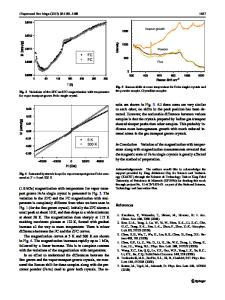Crystal engineering and physicochemical properties of l -threoninium succinate (LTS) single crystal for frequency conver
- PDF / 1,317,499 Bytes
- 11 Pages / 595.276 x 790.866 pts Page_size
- 21 Downloads / 283 Views
Crystal engineering and physicochemical properties of L-threoninium succinate (LTS) single crystal for frequency conversion applications S. E. Allen Moses1,*
, S. M. Ravi Kumar2, and Tejaswi Ashok Hegde3
1
Department of Physics, School of Arts and Science, Vinayaka Mission’s Research Foundation, AVIT Campus, Chennai, Tamil Nadu 603 104, India 2 Department of Physics, S.S Government Arts College, Tiruttani, Tamil Nadu 631 209, India 3 Division of Physics, School of Advanced Sciences, VIT, Chennai, Tamil Nadu 600 127, India
Received: 2 August 2020
ABSTRACT
Accepted: 6 October 2020
The synthesis and characterization of organic nonlinear optical active (NLO) single crystal of L-threoninium succinate (LTS) were carried out in this work. LTS crystal was prepared by slow evaporation technique using deionized water as solvent in a period of 82 days and the obtained LTS crystal was subjected to such characterizations as single-crystal X-ray diffraction analysis, UV–Vis–NIR spectroscopy analysis, FT-IR spectrum analysis, thermal analysis, second harmonic generation, and surface quality analysis. The third-order nonlinear optical properties of the LTS crystal were estimated at 532 nm using semiconductor laser source. Then it was employed for Z-scan analyzer to sense the nonlinear refractive index (n2), absorption coefficient (b), and third-order susceptibility (v3). Through this analysis, this research calculated the n2 = 2.35 9 10–15 (m3/W), b = 1.3057 9 10–8 (m/W), and v3 = 1.0571 9 10-13 (esu) were determined. The obtained results exhibited an appropriate variation in optical limiting behavior of the LTS material which saturates at higher intensities with respect to input and output power. The laser damaged threshold (LDT) technique enables the great resistivity toward optical high energy and it is found to be 52.7 mJ.
Ó
Springer Science+Business
Media, LLC, part of Springer Nature 2020
1 Introduction Research interest on nonlinear optical (NLO) crystal increases on the recent years due to its constructive applications in various fields, such as photonics, optoelectronics, sensors, and optical fibers [1–5].
Address correspondence to E-mail: [email protected]
https://doi.org/10.1007/s10854-020-04621-y
Nowadays, electronics industrial requirements created more attention on NLO crystals and it has to develop new NLO crystals with high thermal, mechanical properties and second-order nonlinear optical coefficients [6–9]. Chiral amino acid crystals with ionic crystals are an excellent agent for optical
J Mater Sci: Mater Electron
material [10, 11]. In addition, the crystals exhibit noncentrosymmetric space groups, weak Van der Waals bonding, hydrogen bonds, zwitterion nature, and wide transparency in the visible region [12, 13]. Some specific organic crystals are showing enhanced nonlinearities when compared to those of KDP and urea. They also showed good electro-optic character when compared with inorganic crystals [14–16]. The attractive optically active behavior showed is shown by of L-threonine due to
Data Loading...










